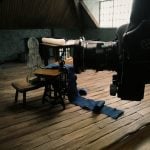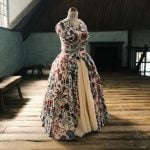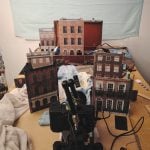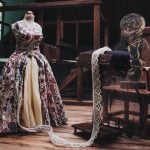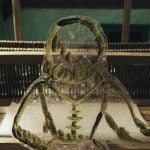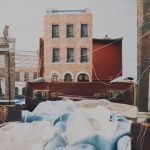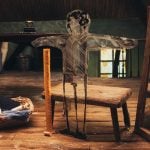One of the things that makes Home so arresting from the start, is the sparse soundtrack coupled with loud ambient sounds and a slow pacing that builds. When figures appear at their knitting looms, in translucent acrylic with scratches reflecting the light as they move, we are solidly in. What follows is a beautifully metaphoric portrayal of several waves of refugees arriving in London: the Huguenots in the early 18th century, Irish in the beginning of the 19th, The Jews in the late 19thc.
Metaphors abound, from a brick home that springs up out of a very old leather suitcase, to the Atlantic Ocean made from an unfurling roll of blue burlap. It is, by and large, a story told through fabrics– the warm yarn knit by the Huguenots, the bright white Irish lace, the bolts of fabrics brough by the Jewish tailors and assembled on old metal sewing machines. Interspersed with negative news stories about the waves of immigration, each time a beautiful little home erects itself bit by bit anyway, each one filled with the materials of the day and the people who came over to live in it.
At the end, with this quote, we understand:
“The house at 19 Princelet Street, East London was a home to refugees for almost 300 years.
It is now a museum of Immigration and Diversity.”
We spoke with animator, Anita Brūvere, who told us a little about her process: “The story is based on the real building in London. It’s a house that was originally built in the early 1700’s in the immigrant area of London, and housed refugees from all over the world throughout its history. I was really fascinated by the building, and all the transformations it went through to accommodate the needs of its different inhabitants. So I wanted to tell this story from the perspective of the house.
“Characters in the film are just passing shadows, and are animated as 2D replacement cut outs, whilst everything else is object animation. I have also used a lot of fabric throughout. Since all the immigrants living in that area of London had a connection to the fabric trade, it seemed a particularly fitting material to use.”
We asked how the overall production went for Brūvere. “Animation takes so long to produce,” she told us. “Making an independent animated short is in itself a challenge. All the crew were accommodating this project alongside their other work, so logistically it was difficult. Especially since we were working towards a tight deadline.
“Creatively, it was challenging to shoot everything in chronological order, as I needed to keep changing the sets to portray the house ageing. It was quite scary knowing that I wouldn’t be able to go back and reshoot or add new shots.”
The end result is a quiet, moving piece that manages to encapsulate identity, immigration, and the true essence of a home, all in a very short time. Well done, team!
Interested in learning more about the production? See below for some behind-the-scenes pics:

